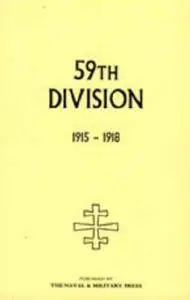59th Division. 1915-1918 by E. U. Bradbridge
English | 2006 | ISBN: 1843429942, 1847344755, 9781843429944, 9781847344755 | 244 Pages | PDF | 4.50 MB
English | 2006 | ISBN: 1843429942, 1847344755, 9781843429944, 9781847344755 | 244 Pages | PDF | 4.50 MB
The 59th Division was a Territorial second-line division (2nd N Midland), that came into existence in January 1915. In April 1916, following the Easter Uprising, the division was sent to Ireland, to Dublin, the first TF division to serve in Ireland. After suppressing the trouble in Dublin the 59th was sent to the Curragh where it engaged in war training for the rest of the year, returning to England in January 1917. In the following March the division crossed to France and served thereafter on the Western Front - at Third Ypres, Cambrai, at St Quentin and Bapaume in the German offensive of March 1918, at Baileul and Kemmel Ridge during the German offensive on the Lys in April 1918. In early May the division was reduced to training cadre status, losing its infantry battalions and other units, but the following month it was reconstituted with Category B men from Garrison Guard battalions. After a period of training the division went back into the line at the end of July and took part in the operations east of Amiens in August and in the final advance in Artois and Flanders.'This account is unusual in two respects: in the first place it is not a formal history but a series of narratives contributed by commanders and others, from GOC down to a WO at divisional HQ, describing events from their point of view; and in the second place there is a separately published supplement containing further narratives from one of the brigade commanders, from the OCs field squadrons, RE and from one of the divisional RASC company OCs. One of the narratives describes a brigade’s operations against the Sinn Fein in Dublin, in which on one occcasion brigade casualties amounted to 19 officers and 143 other ranks of whom 30 died. The supplement is included in this reprint. Among the appendices is one quoting examples of acts of gallantry including one of the two VCs awarded; another gives a summary of the divisional record from formation to armistice and there are extracts from official correspondence and operational orders. Various recreational events are described - horse races, competitions for divisional transport, field ambulances, signal company and other equestrian events. One very useful item is a table listing all the division’s moves, with dates, from arrival in France on 26 February 1917 to 8 March 1919, giving locations and Corps and Army subordination.



